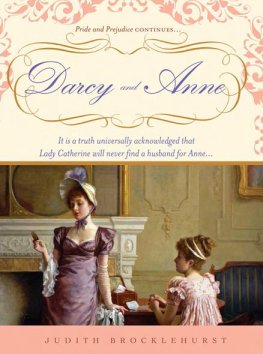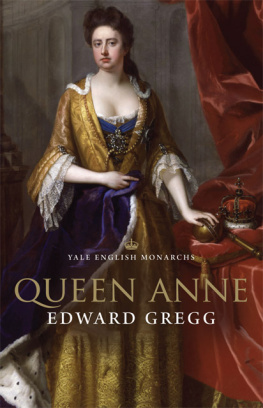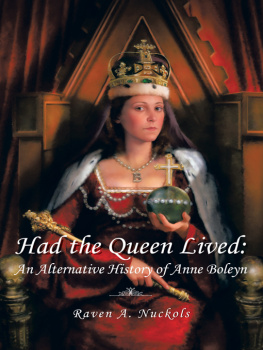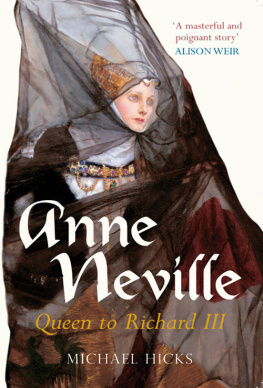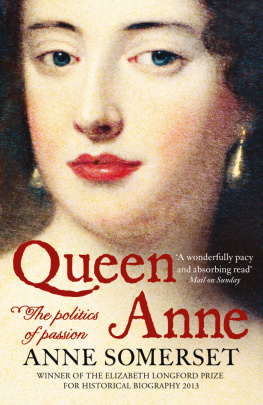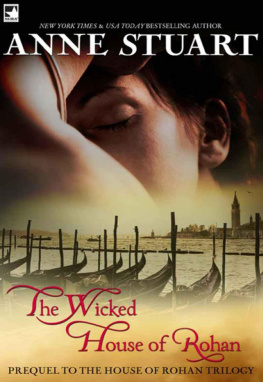
House of Stuart

Good Queen Anne
Appraising the Life and Reign of the Last Stuart Monarch
JUDITH LISSAUER CROMWELL

McFarland & Company, Inc., Publishers
Jefferson, North Carolina
ALSO BY JUDITH LISSAUER CROMWELL
Florence Nightingale, Feminist (McFarland, 2013)
Dorothea Lieven: A Russian Princess in London and Paris, 17851857 (McFarland, 2007)
ISBN (ebook) 978-1-4766-3582-8
2019 Judith Lissauer Cromwell. All rights reserved
No part of this book may be reproduced or transmitted in any form or by any means, electronic or mechanical, including photocopying or recording, or by any information storage and retrieval system, without permission in writing from the publisher.
The front cover portrait of Queen Anne is by Michael Dahl, circa 1702, oil on canvas ( National Portrait Gallery, London)
McFarland & Company, Inc., Publishers
Box 611, Jefferson, North Carolina 28640
www.mcfarlandpub.com
To my father, John Lissauer, MD
Preface
Of the few women who ruled England in their own right, Queen Anne is least known and most underrated. Yet, her brief reign (17021714) marked a glorious period in her countrys history, a period in which Anne Stuart played a key part.
Her small island nation off the coast of continental Europe rose from the chaos of regicide, civil war, and revolution to the cusp of global supremacy, an advance mainly due to the men Anne chose to lead her army and government.
Queen Anne inherited the throne of a Protestant nation already committed to combat the hegemony of Europes superpower, Catholic France. With their country on the verge of a momentous war, many of the new queens subjects feared for their nation, now to be led by an unproven ruler, and a woman, no less. But this ailing female who, after seventeen pregnancies had failed in her most important dutyto provide her country with an heir, a female, moreover, without any formal training in statecraft, would prove the skeptics wrong.
In early youth, Anne did not anticipate becoming queen. Her uncle, King Charles II, as well as his brother and heir, Annes father James, could still sire sons; besides, Anne had an older sister. At best, and because Annes status as a royal princess meant her marriage must be subject to state concerns, she could expect compatibility and the joys of motherhood. But as a young woman, the prospect of becoming queen arose, especially when Princess Anne decided to preserve her Protestantism despite her Catholic father King James IIs attempts to convert her, as well as the country.
When she thinks herself in the right, she needs no advice to help her to be very firm and positive. Anne had neither education in, nor experience of, government. But she grew up in a court notorious for depravity and deceit, a court where adders dangled from the trees, and alligators slithered underfoot. That taught the kind-hearted princess valuable lessons about life and the human psyche. She evolved into an astute head of state, deftly navigating the shoals of power politics and party polarity to steer a middle course between combative political parties.
The queen favored Tories over Whigs. But in order to keep the crown independent, and function as a unifying force, she preferred a mixed ministry, one made up of moderates from both the Whig and Tory parties. Anne thus acted as a brake on the ambitious men around her.
Despite her limitations, not the least of which consisted of the contemporary notion that females were inferior to men, Anne turned out to be an effective ruler. Pragmatism and a strong sense of duty resulted in sound decisions, even brave onesafter her predecessor King William IIIs death, Anne could easily have withdrawn from the Grand Alliance against France; instead, she steadily supported her handpicked captain general, John Churchill, Duke of Marlborough, against the advice of several senior ministers.
A peace-loving woman, Anne backed the long, costly War of the Spanish Succession until she judged the time right to end it. The Peace of Utrecht, signed a year before the queens death, gave Great Britain the means to create an empire that would give the world its language and its form of government.
An eruption of patriotism and approval greeted Annes advent to the throne, and lasted throughout her reign. Annes subjects knew that, like them, Their Queen had no foreign blood, like them she adhered to the Church of England; and that their welfare and her love of country would guide Annes decisions.
Patriotism, piety, and a happy home life sustained Anne Stuart. Her marriage to Prince George of Denmark had its genesis in geopolitics. But Annes greatest blessing, on earth [consisted of the] entire union of affections and inclinations, between her and her royal consort; [they were a] perfect pattern of conjugal love.
Bereft, at an early age, of close female relatives, surrounded by sycophants, or, worse, spies, Anne yearned for a friend. She found one in Sarah Churchill, Duchess of Marlborough.
Both ambitious, the two young women were close, absorbed in domesticity but concerned about the future. Until fate made one of them queen.
That doomed the friendship. Consequently, Sarah concentrated her multiple memoirs on justifying herself and disparaging Anne. And since Sarahs papers constitute the most complete account of her long relationship with the queen, Sarahs pen left posterity a picture of Anne as a dim-witted, religious hypocrite constitutionally incapable of independent thought, a puppet in the hands of others.
My re-examination of archives, as well as the welter of often contradictory contemporary and later evidence, reveals a different story. Although some recent biographies have given Queen Anne the respect she deserves, their focus on political intricacies tends to overshadow everything else about the queen. My book differs because, for the first time, it tells Annes Stuarts story from a nuanced perspective. Succinct, yet comprehensive and meticulously researched, Good Queen Anne paints a rounded portrait of a popular and sensible head of state, a loving and beloved wife, a woman who indulged in her passion for music, delighted in her gardens, enjoyed hunting and horse-racing; above all, a resolute female who succeeded in resolving the central conflict in her life: Anne Stuart overcame personal tragedy and physical frailty to become a revered and effective queen.
Good Queen Anne owes a debt of thanks to many. The British Library manuscript reading room librarians; Columbia University research librarians; and the facilities of the New York Public Library. My gratitude for permission to quote from their manuscripts to the British Library Board, the Morgan Library & Museum; for permission to use their images as illustrations to the British Museum Board, the National Portrait Gallery London, and the Royal Collection Trust. My appreciation, as always, for their support and forbearance, to my family and friends.
One
Something of majesty
I am very glad to hear that your indisposition of health is turned into a great belly. I hope you will have better luck with it than the duchess here had, who was brought to bed of a girl.King Charles II to his favorite sister Henriette-Anne, Duchess of Orlans.
Next page


